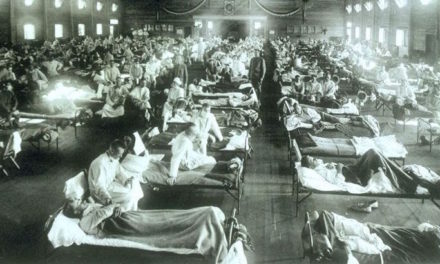The sixth century AD was a tumultuous period of human history. It marked the end of Classical Antiquity and the beginning of the Middle Ages. Empires fell and new ones rose up to take their place. It was during this period that the legendary King Arthur is said to have led the defence of Britain against Saxon invaders and that Beowulf ruled the Geats. It is also during this period that the most severe phase of global cooling in the last 2,000 years occurred and that the Plague of Justinian devastated the Byzantine Empire.
The Great Dust Veil of 536 AD
In the summer of 536 AD, a mysterious and dramatic cloud of dust appeared over the Mediterranean. This thick veil of dust seemingly appeared from nowhere and darkened the skies between Europe and Asia for almost 18 months. The Byzantine historian Procopius wrote in his report on the wars with the Vandals:
“During this year a most dread portent took place. For the sun gave forth its light without brightness… and it seemed exceedingly like the sun in eclipse, for the beams it shed were not clear”
The dust veil was seen as far east as China and the star Canopus, used by the Chinese to assure themselves of good times ahead and to demark the seasons, was not seen for over a year. There was also summer snow and frost reported there that year. Tree-ring analysis from the same period shows abnormally low growth levels in areas as far apart as Ireland, Sierra Nevada and Chile. Further scientific evidence is provided by ice cores from Greenland and Antarctica, which demonstrate the presence of substantial sulfate deposits, indicating the presence of an extensive acidic dust layer.
In the 18 months that followed there was a period of dramatic global cooling, unseasonal freak weather events, crop failures and famine. The effects must have been terrifying for the people that lived at the time.
The actual cause of this bizarre metrological anomaly has long baffled scientists and historians but the two most often quoted are the ‘volcanic winter’ theory and the ‘comet impact’ theory.
Volcanic Winter or Comet Impact?
Over the past 30 years or so there have been numerous hypotheses that the global cooling of 536 AD was triggered by a major volcanic eruption that released an immense amount of ash into the atmosphere. In 1984 the Astrophysicist and climate change expert Dr Richard Stothers suggested that it was caused by an eruption of the Rabaul volcano. More recently in 2013 the American paleoecologist Dr Robert Dull has suggested that it was actually an eruption of El Salvador’s Lake Ilopango in 535 AD that was responsible.

Ash cloud from the eruption of the Rabaul volcano in 2009 (Image courtesy of Taro Taylor CC BY-SA 2.0)
Another popular theory is that the dust veil was due to a comet impact into the ocean that blasted massive quantities of water vapour and debris back into the upper atmosphere. Ice-core Analysis of Greenland ice that was laid down between 533 and 540 AD shows high levels of tin, nickel and iron oxides from an extraterrestrial source in the dust layer. This has led some scientists to conclude that the material was shed by a fragment of Halley’s comet that may have hit the Earth at around that time.

NASA image of Halley’s comet from 1986.
It is even possible that both of these events may have happened with a comet impact and a major volcanic eruption occurring at around the same time and both playing a contributing role to the appearance of the dust veil.
The Plague of Justinian
The appearance of the dust veil in 536 AD had a major impact on the people of the time. Global cooling and colder summers caused crops to be damaged before they could be harvested. Widespread famine ensued and this subsequently made the people of the time more susceptible to disease.
In 541 AD a mysterious illness began to appear on the outskirts of the Byzantine Empire. Victims were described as suffering from delusions, nightmares, fevers and swellings in the groin, armpits, and behind their ears. The lucky ones died quickly whilst those less fortunate suffered for many days before their eventual demise. The plague arrived in Constantinople, the capital of the empire, the following year in 542 AD. Procopius was once again on the scene to record the events. He noted that bodies were left stacked in the open due to a lack of space for proper burial and during his lifetime he lost his wife, daughter, grandchildren and most of his servants to the plague. He recorded that at its peak the plague was killing 10,000 people in Constantinople daily, although modern historians feel the real number was closer to 5,000.
The plague has since become known as the Plague of Justinian, being named after emperor Justinian I (527-565 AD), during whose reign it occurred. Procopius blamed the emperor for the plague, declaring that Justinian was either a devil or that he was being punished by God for his evil ways. The emperor himself even contracted the plague, although he was one of the lucky few that survived.
What caused the Plague of Justinian?
It had long been suspected from Procopius’ description that the Plague of Justinian was, in fact, bubonic plague, the cause of the infamous Black Death that occurred in the 14th century. In 2012 it was finally confirmed that this was the case. A team of researchers analysed human remains from ancient gravesites from the period and detected the presence of Yersinia Pestis DNA.
Yersinia Pestis is a particularly nasty bacterium that can infect both animals and humans. It uses rats and other rodents as a reservoir species. Fleas then act as a vector species, acquiring Yersinia Pestis whilst feeding on the infected rodent and the bacteria is then passed to humans via a fleabite. The classic sign of bubonic plague are buboes, horribly swollen lymph nodes. These most commonly appear in the inguinal nodes, situated in the groin region because most fleabites occur on the legs. Those infected will first experience fevers, chills and muscle pains before developing septicaemia or pneumonic plague. Death can occur in less than 2 weeks.

Yersinia Pestis in the gut of an infected flea seen through a scanning electron microscope
It seems that just as The Black Death was carried by rat fleas living on black rats that were passengers on merchant ships, so too was the Justinian Plague carried around the ports and trade routes of the Mediterranean.
The outbreak lasted less than 6 months in Constantinople but it is estimated that 40% of those living there died in that time period. The plague would reappear at periodic intervals over the next 300 years and it would eventually claim the lives of 25% of people living in the Mediterranean region. It is estimated that somewhere in the range of 25-50 million people died in total as a consequence of this catastrophic illness. The last recorded recurrence was in 750 AD, but by this time the outbreaks had become less virulent. The plague would then disappear from Europe completely until the 14th Century.
The aftermath of the Plague
The exact cause of the dust veil and global cooling that occurred in 536 AD may never be known for certain but it is known that it resulted in widespread hardship and famine for the people of the time. It may have also contributed to the advent of one of the most devastating plagues in human history that depopulated the Mediterranean and devastated the Byzantine Empire. Whatever the cause the course of human history was changed forever and Europe would not fully recover until the rise of the Renaissance.







I had no idea of any of this occurring. Thank you for making this available. A friend of mine happened to send me a link to your site. Excellent work.